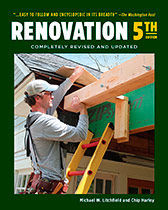Podcast 233: Hardwood Flooring, Windows in Rain Screen Walls, and Duct-Free Ventilation Systems
The crew hears from listeners about housing costs and box stores before taking questions on the right way to flash windows in a rain-screen wall, preventing hardwood floor squeaks, and supplying fresh air for HRV’s and ERV’s.
Follow the Fine Homebuilding Podcast on your favorite app. Subscribe now and don’t miss an episode:
 |
 |
Rob, Colin, and Patrick hear from Ian and Bruce about housing costs. Adam writes in about his experience at the home center. Taylor asks how to best flash the new windows in his rain screen walls. Paul asks how to keep his hardwood floors from squeaking and Jeff wants to know how to install a ventilation system without ductwork.
Listener Feedback:
Listener feedback #1
Andy Engel writes, Regarding the housing costs in episode 230. There are many, many factors of course, but land development looms very large. Look around any built-up town and you’ll probably see that the easy building lots got used up years ago. What’s left isn’t flat, well-drained corn fields. It’s steep, rocky parcels that at least in Connecticut, have sensitive wetlands that require protection. Certainly that’s not the case everywhere, but around here it is. Anytime you need a hydraulic hammer on an excavator, or dynamite, to put in a road or a foundation hole, your costs skyrocket.
Listener feedback #2
Bruce from Lincoln, RI writes, Interesting show this week (Podcast #230)
On the affordable house issue, it’s all about the land, they’re not making any more of it.
Regulation usually means zoning and it’s the lever existing residents pull to keep development expensive. I’m a long time TV/print media member and every Zoning commission meeting has a few regulars to whom the answer to any question is No! On the flip side developers want to pack as many high–end homes onto the land they’ve acquired regardless of how the project will affect the area.
It would be nice if planners and developers would cooperate to develop affordable housing in appropriate spaces that are near public transportation.
Listener feedback #3
Adam in Virginia writes, I was driving in this morning catching up on some FHB podcasts and couldn’t believe what I heard. In episode 2015 Justin said he loves the big box stores? You should test him for coronavirus. The big box stores are the worst. Here are just a few reasons why.
1. The products they sell are often of questionable quality. For example, it’s a fact that the toilets they sell are those that come off the production line with minor imperfections. Granted I’m not reading stories about toilets failing across the nation but I’ve had a few fail on me. So why risk it? Everyone should just go to their local plumbing supply and get a Toto and never worry again. Ditto with pex and most other plumbing products (I know Justin likes plumbing)
2. As Justin accurately pointed out, for some dumb reason they don’t sell entire systems. So now I’m taking a half day to drive from store to store trying to find the one thing I need to finish what was supposed to be a 15 minute job.
3. You’re design limits are constrained but what they sell, which is boring and bad quality.
4. No one working in the stores has any clue of high performance building.
5. Tool manufacturers design their products based on what the big box stores tell them they need. So my Dewalt drill is designed for the weekend DIYer and not the pros. This explains why I’m going through drills every few years.
I will admit the negatives are somewhat balanced out by convenience. I like being able to get things quick on a Sunday or after 5 at night when they supply house is closed. Still, as you can probably tell, I’m not a fan of the blue or orange stores.
Editor Updates:
Colin’s Sister’s gabel-end repairs
Jeff’s In-law’s kitchen
Rob’s burning CFLs
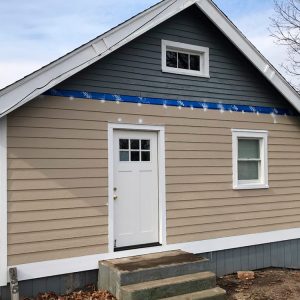 |
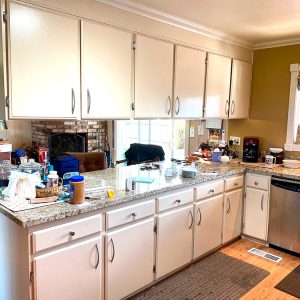 |
 |
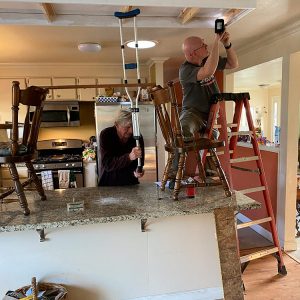 |
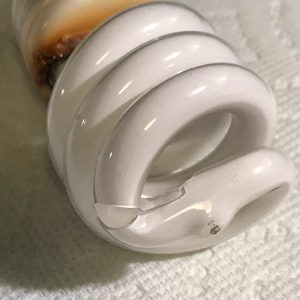 |
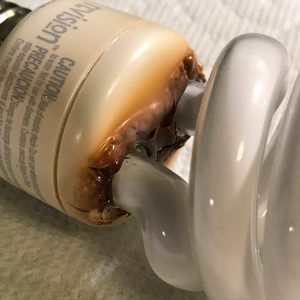 |
Question 1: Another listener asks about flashing-product substitutions

Today’s question is about windows. This coming summer I plan to reside with Hardie board. I will be removing the old asphalt siding and adding 2” of poly-iso, a WRB, and a rain screen behind the Hardie. When I get to the windows I want to bump them out 3” so they line up with the siding correctly. I have seen a lot of great details on how to flash and waterproof the windows when doing this. It looks to me like the best option is to use a mixture of flashing tape and liquid flash.
My question is, do I need to use a liquid flash specific product or is there something that I can get more readily like an ISO or Vulkem product and apply that in the same fashion? I’m not against buying the liquid flash if it’s the only way, but I also like to be thrifty where it makes sense.
Thanks for the great material! Keep it up.
Related links:
- What Happens When Building Materials Don’t Like Each Other?
- Coping With the Revolution in Building Materials
Question 2: How should I install hardwood flooring so it doesn’t squeak?
A listener in NE Ohio writes, Hi Podcast Crew! Love the show!
Warning: I can be a little long winded—and—-I’m an engineer.
I’m also a serial DIY remodeler. I’ve done pretty much everything you can do to a house short of building one from the ground up, or anything much involving masonry.
My wife and I are in the early stages of remodeling our home office in NE Ohio. What type of flooring and what installation method will minimize floor squeaks (or other problems) down the road. The area is over a finished and conditioned basement space that is generally in the 40-50% humidity range. The room is about 12×18 and the 2×10 joists which are 16” on-center run the 12’ direction.
I know that a lot of squeaks are due to poor subfloor condition or installation. This area has 3/4” plywood subfloor, and I’ll be screwing it down tightly to the joists and fixing any issues before installing any flooring.
In our dining room, I installed engineered hardwood T&G planks using a floating installation where the planks were glued together during installation over a thick poly vapor retarder covered with ¼ sheet cork. This was all per manufacturer’s installation instructions. It was a bit of a pain to install, since strap clamps had to be used every few rows, and one had to be on the lookout for glue squeeze out. But the floor looks wonderful, and there is not a squeak to be heard (although it’s only been a year or two).
So I would be comfortable going that same route in the office. However, that’s a fairly pricey way to go. High quality engineered hardwood is expensive, and the cost of the cork adds to that. My shopping tells me high quality prefinished solid hardwood planks tend to be less expensive than the engineered hardwood, and installing with a pneumatic cleat nailer would sure be faster. But I can honestly say that I’ve never been in a house more than a few years old where the conventional hardwood floors didn’t squeak. The HW floors in other rooms in our house squeak horribly.
It seems to me that tightly tying solid wood to plywood with a zillion little metal barbs is a fool’s errand. The wood is going to move over time and with the seasons, the plywood will move less, so eventually the planks will loosen enough to move against each other and against the cleats and start squeaking. But I want opinions from the pros. Is there a way to install prefinished hardwood so that it is unlikely to squeak?
There’s a lot out there on the web about fixing squeaking floors, but not much I could find about avoiding or preventing squeaks, aside from the advice about sound subflooring.
If it matters, we will likely be going with maple flooring regardless of particular type.
Hope you folks can shed some light on this!
Special shout out to Kiley; her perspective is a good addition to the show.
Howard Brickman replies: Use felt. “I have often seen damage done to wood flooring from “acclimating” the flooring to the job before installation. Because the quality of kiln-drying within the wood flooring industry is high, acclimation is only appropriate in extreme climates where interior relative humidity levels are substantially above or below the 7.5% MC/40% RH manufacturing specifications. This includes the arid regions of the western U.S. and the humid southeastern U.S. Acclimating wood flooring in other regions actually risks exposing it to the high levels of relative humidity and moisture present during summer or on a new construction site. This will cause the wood flooring to swell before and during installation. Then, during the first heating season, it will shrink and permanent spaces will be left between the flooring strips. Instead, dry out the building before bringing the flooring on site.”
You want 9 nails per sq. ft.
| Floor width 1 1/2 2 1/4 3 3 1/4 4 5 6 7 8 |
Nail spacing 10 to 11 6 to 8 5 to 6 5 4 3 to 4 3 2 to 3 2 |
Related links:
- NWFA is Making Sweeping Changes to Their Wood-Flooring Installation Guidelines
- A Closer Look at Solid-Wood Flooring
Question 3: How can I install an ERV or HRV if I’ve got no room for ductwork?
Jeff writes, One question that comes up frequently on the podcast is how to bring in fresh air to the building (ERV, HRV, etc). While this may be easier with ducted heating and cooling system, it may be more challenging with a hydronic heat system, such as a gas/oil fired furnace with base board, and no central a/c. How can one bring in fresh air and exhaust stale air when no ductwork exists?
Related links:
End Note:
Check out our new comprehensive guide about building decks, with hundreds of articles and dozens of videos covering everything from design to framing to finish details and more.
If you have any questions you would like us to dig into for a future show, shoot an email our way: [email protected].
If we use your question we’ll send you a FHB Podcast sticker!
 #KeepCraftAlive
#KeepCraftAlive
KeepCraftAlive hats help celebrate the value of true craftsmanship–plus 50% of all proceeds from every hat sold go to the #KeepCraftAlive Scholarship Fund, supported by Fine Homebuilding and SkillsUSA.
Buy a #KeepCraftAlive hat or t-shirt
This episode of the Fine Homebuilding podcast is brought to you by ZIP System building enclosures.
By creating the integrated sheathing alternative to “layered” roof and wall assemblies, ZIP System sheathing and flashing options provide a streamlined approach to exterior water, air and thermal management. Did you know ZIP System has been on the market for over 10 years and not only comes with a 180-Day Exposure Guarantee and 30-Year Limited Warranty, but decades of research from the scientists and innovators at Huber Engineered Woods. Learn why so many building teams have make the switch to ZIP System building enclosures and how to get it on your next project at the new ZIPSystem.com.
Also brought to you by Danner:
If you believe in timeless ideas like quality, craftsmanship, and blazing your own path, I want to introduce you to our friends at Danner who sponsor this podcast. A Pacific Northwest original for over 85 years, Danner makes boots for people with purpose in their step. Boots like the new Steelyard family—featuring 8 different models with game-changing comfort, legendary durability, and performance features for any jobsite. Earn a pair and join the family at Danner.com.
Also brought to you by Benjamin Obdyke:
Benjamin Obdyke would like to use the special occasion of our 150th anniversary to thank the nuisances that builders and homeowners despise. Our premium products protect from those pesky things like rain, snow, UV rays and the neighbor’s sprinkler system. Take HydroGap, a drainable housewrap that eliminates moisture from your wall assembly. Or the new InvisiWrap UV, an all-black WRB, perfect for long-term moisture protection behind open joint siding.
Fine Homebuilding podcast listeners can now get 20% off anything in the Taunton store, including the Renovation 5th Edition.
Use the discount code FHBPODCAST to take advantage of this special offer.
We hope you will take advantage of a great offer for our podcast listeners: A special 20% off the discounted rate to subscribe to the Fine Homebuilding print magazine. That link goes to finehomebuilding.com/podoffer.
The show is driven by our listeners, so please subscribe and rate us on iTunes or Google Play, and if you have any questions you would like us to dig into for a future show, shoot an email our way: [email protected]. Also, be sure to follow Justin Fink and Fine Homebuilding on Instagram, and “like” the magazine on Facebook. Note that you can watch the show above, or on YouTube at the Fine Homebuilding YouTube Channel.
The Fine Homebuilding Podcast embodies Fine Homebuilding magazine’s commitment to the preservation of craftsmanship and the advancement of home performance in residential construction. The show is an informal but vigorous conversation about the techniques and principles that allow listeners to master their design and building challenges.
Other related links
-
- All FHB podcast show notes: FineHomebuilding.com/podcast.
- #KeepCraftAlive T-shirts and hats support scholarships for building trades students. So order some gear at KeepCraftAlive.org.
- The direct link to the online store is here.


